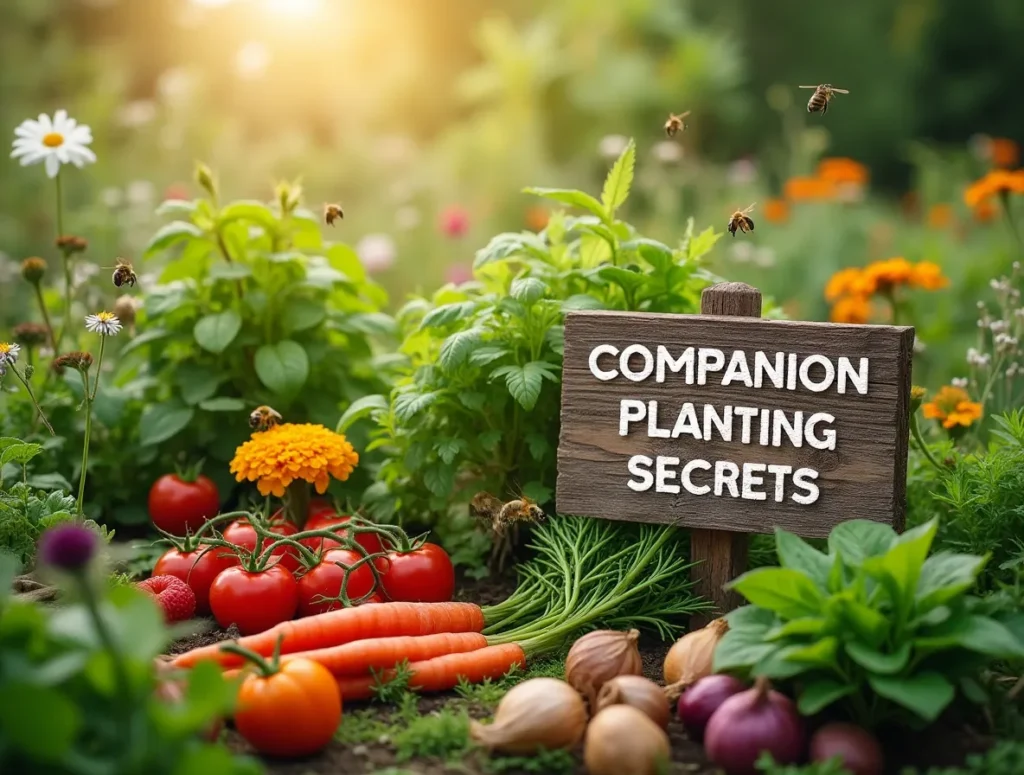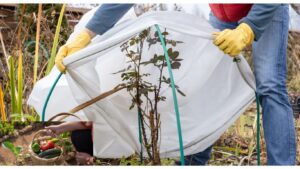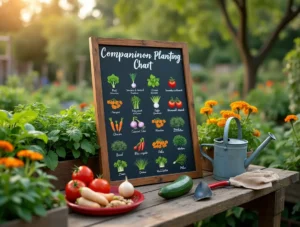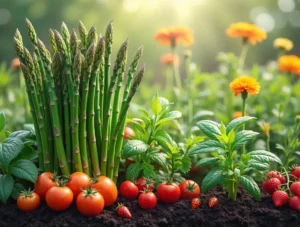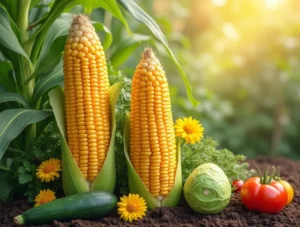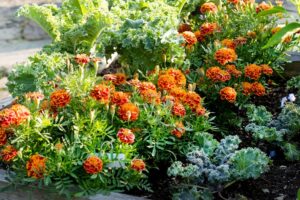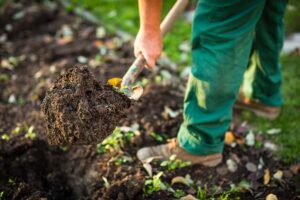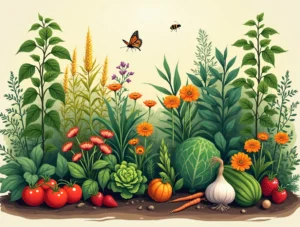Have you ever wondered why some plants thrive when grown together, while others struggle? This is the magic—and science—of companion planting, a gardening practice that pairs certain plants to help them grow better, repel pests, and improve soil health. Whether you’re a seasoned gardener or just starting out, understanding companion planting can transform the way you approach your garden.
But here’s the catch: while companion planting has been celebrated for centuries, not all the advice you’ll find online or in gardening books is backed by science. Some tips work brilliantly in one region but fall flat in another. So, is companion planting a gardening miracle or just an old wives’ tale?
In this article, we’ll dive into the myths and realities of companion planting, exploring its origins, proven benefits, and practical tips to help you make the most of this ancient practice. Whether you’re looking to boost your garden’s productivity, reduce pests naturally, or simply experiment with new techniques, companion planting might just be the key to a healthier, more vibrant garden. Let’s dig in!
On This Page
The Origins of Companion Planting
Companion planting isn’t a new trend—it’s a practice rooted in centuries of observation and experimentation. Long before modern agriculture, farmers and gardeners noticed that certain plants grew better together, while others seemed to compete or attract pests. These observations led to the development of companion planting, a method that has been passed down through generations.
One of the earliest examples of companion planting comes from Indigenous cultures in the Americas, who practiced the “Three Sisters” method. This involved planting corn, beans, and squash together. The corn provided a natural trellis for the beans to climb, the beans fixed nitrogen in the soil to nourish the corn and squash, and the squash’s large leaves shaded the ground, suppressing weeds and retaining moisture. This symbiotic relationship is a perfect example of how companion planting can create a balanced, productive garden ecosystem.
In Europe, companion planting also has deep roots. Medieval gardeners often paired plants like roses with garlic, believing the strong scent of garlic would deter pests from attacking the roses. Over time, these traditional pairings became part of gardening folklore, with some combinations proving effective and others less so.
While the science behind companion planting has evolved, its core principle remains the same: by understanding how plants interact, we can create gardens that are healthier, more resilient, and less reliant on chemical interventions. In the next section, we’ll explore some of the myths surrounding companion planting and separate fact from fiction.
The Myth: Does Companion Planting Always Work?
When it comes to companion planting, there’s no shortage of advice—plant marigolds to repel nematodes, grow basil with tomatoes for better flavor, or pair carrots with onions to deter pests. But here’s the truth: not all companion planting advice works everywhere, and some of it is based more on tradition than science.
One of the most common myths is that marigolds repel nematodes in all gardens. While this is true in some regions, like England, where the practice originated, it doesn’t work as well in other parts of the world. For example, in Australia and New Zealand, the local nematode species aren’t affected by marigolds at all. Even in North America, marigolds may only chase nematodes away from their roots, sending them straight to your other plants.
Another misconception is that companion planting is a one-size-fits-all solution. In reality, the success of companion planting depends on factors like soil type, climate, and the specific pests in your area. What works in a cool, damp English garden might not work in a hot, dry climate like Arizona or Texas.
So, does this mean companion planting is a waste of time? Not at all! While some pairings may not live up to the hype, others have proven benefits. The key is to approach companion planting with a critical eye, experiment in your own garden, and focus on combinations that are backed by science and adapted to your local conditions.
In the next section, we’ll explore the real benefits of companion planting and how you can use it to create a healthier, more productive garden.
The Reality: How Companion Planting Can Benefit Your Garden
While not every piece of companion planting advice is foolproof, there are plenty of proven benefits that make it a valuable tool for any gardener. When done right, companion planting can help you create a healthier, more balanced garden ecosystem. Here’s how:
1. Natural Pest Control
One of the most well-documented benefits of companion planting is its ability to repel pests or attract beneficial insects. For example:
- Basil and tomatoes: Basil can help deter whiteflies and aphids, while also improving the flavor of tomatoes.
- Nasturtiums and cucumbers: Nasturtiums act as a trap crop, luring aphids away from your cucumbers.
- Marigolds and beans: While marigolds may not work for all nematodes, they can still deter other pests like bean beetles.
2. Improved Soil Health
Some plants naturally improve soil fertility, making them excellent companions for nutrient-hungry crops. For instance:
- Beans and corn: Beans fix nitrogen in the soil, which benefits nitrogen-loving plants like corn.
- Clover and fruit trees: Clover acts as a living mulch, suppressing weeds and adding nitrogen to the soil.
3. Efficient Use of Space
Companion planting allows you to maximize your garden space by pairing plants with different growth habits. For example:
- Tall plants and shade-loving crops: Sunflowers or corn can provide shade for lettuce or spinach, which prefer cooler conditions.
- Vining plants and sturdy supports: Pole beans can climb up corn stalks, saving space and creating a natural trellis.
4. Enhanced Flavor and Growth
Some plant pairings can even improve the flavor or growth of neighboring crops. For example:
- Carrots and onions: Onions can deter carrot flies, while carrots help aerate the soil for onions.
- Tomatoes and basil: Basil is said to enhance the flavor of tomatoes, and the two plants grow well together.
5. Biodiversity and Resilience
By diversifying your garden with companion planting, you create a more resilient ecosystem. A mix of plants can attract beneficial insects, improve soil health, and reduce the risk of pest outbreaks.
While companion planting isn’t a magic solution, it’s a powerful tool when used as part of a broader organic gardening strategy. In the next section, we’ll explore some of the most effective companion planting pairings you can try in your own garden.
Common Companion Planting Pairings That Work
Now that we’ve explored the benefits of companion planting, let’s dive into some tried-and-true plant pairings that have stood the test of time. These combinations are backed by both tradition and science, making them a great starting point for your garden.
1. Tomatoes and Basil
- Why it works: Basil repels pests like whiteflies and aphids, while also enhancing the flavor of tomatoes.
- How to plant: Grow basil around the base of tomato plants or in nearby pots.
2. Carrots and Onions
- Why it works: Onions deter carrot flies, while carrots help aerate the soil for onions.
- How to plant: Alternate rows of carrots and onions, or interplant them in the same bed.
3. Corn, Beans, and Squash (The Three Sisters)
- Why it works: Corn provides a trellis for beans, beans fix nitrogen in the soil, and squash shades the ground to suppress weeds.
- How to plant: Plant corn in hills, then add beans and squash around the base.
4. Lettuce and Radishes
- Why it works: Radishes grow quickly and can be harvested before lettuce needs more space. They also help break up the soil for lettuce roots.
- How to plant: Sow radish seeds between rows of lettuce.
5. Cucumbers and Nasturtiums
- Why it works: Nasturtiums act as a trap crop, attracting aphids away from cucumbers.
- How to plant: Plant nasturtiums around the edges of your cucumber patch.
6. Peppers and Marigolds
- Why it works: Marigolds repel pests like nematodes and aphids, protecting pepper plants.
- How to plant: Plant marigolds around the perimeter of your pepper bed.
7. Cabbage and Dill
- Why it works: Dill attracts beneficial insects like ladybugs and parasitic wasps, which prey on cabbage pests.
- How to plant: Plant dill near cabbage, but not too close, as it can grow tall and shade the cabbage.
8. Strawberries and Borage
- Why it works: Borage improves the flavor of strawberries and attracts pollinators like bees.
- How to plant: Plant borage around the edges of your strawberry patch.
9. Potatoes and Horseradish
- Why it works: Horseradish deters potato beetles and other pests.
- How to plant: Plant horseradish at the corners of your potato bed.
10. Roses and Garlic
- Why it works: Garlic repels aphids and other pests that love roses.
- How to plant: Plant garlic bulbs around the base of rose bushes.
These pairings are a great starting point, but remember: companion planting is not an exact science. What works in one garden may not work in another, so don’t be afraid to experiment and take notes on what works best for you.
Tips for Successful Companion Planting
Ready to try companion planting in your garden? While the concept is simple, a little planning and experimentation can go a long way in ensuring success. Here are some practical tips to help you get the most out of this gardening technique:
1. Know Your Garden’s Conditions
- Soil type: Some plants thrive in sandy soil, while others prefer clay or loam. Test your soil and choose companion plants that suit its conditions.
- Climate: Consider your local climate and growing season. Some plants, like basil, love heat, while others, like lettuce, prefer cooler weather.
- Sunlight: Make sure your companion plants have similar light requirements. For example, don’t pair sun-loving tomatoes with shade-tolerant spinach.
2. Start Small and Experiment
- Don’t overhaul your entire garden at once. Start with a few proven pairings, like tomatoes and basil or carrots and onions, and see how they perform.
- Keep a garden journal to track which combinations work best in your garden. Over time, you’ll develop your own companion planting guide tailored to your space.
3. Rotate Your Crops
- Crop rotation is essential for preventing soil depletion and pest buildup. Avoid planting the same crops (or their close relatives) in the same spot year after year.
- Use companion planting as part of your rotation strategy to keep your garden healthy and productive.
4. Combine with Other Organic Practices
- Mulching: Mulch helps retain moisture, suppress weeds, and improve soil health, creating a better environment for companion plants.
- Composting: Add compost to your soil to boost fertility and support healthy plant growth.
- Integrated Pest Management (IPM): Use companion planting alongside other pest control methods, like attracting beneficial insects or using organic sprays.
5. Avoid Overcrowding
- While companion planting can save space, overcrowding can lead to competition for nutrients, water, and sunlight. Give your plants enough room to grow and thrive.
6. Be Patient and Observant
- Companion planting isn’t a quick fix—it’s a long-term strategy. Pay attention to how your plants interact and make adjustments as needed.
- If a pairing doesn’t work, don’t be discouraged. Gardening is all about learning and adapting.
7. Use Companion Planting as Part of a Bigger System
- Think of companion planting as one piece of the puzzle. Combine it with other organic gardening practices, like crop rotation, mulching, and composting, to create a thriving, sustainable garden.
Conclusion: Embracing Companion Planting in Your Garden
Companion planting is more than just a gardening trend—it’s a time-tested practice that can help you create a healthier, more productive garden. While it’s not a magic solution, it offers a natural way to control pests, improve soil health, and make the most of your garden space.
The key to success with companion planting is to approach it with curiosity and flexibility. Not every pairing will work perfectly, and that’s okay. Gardening is a journey of discovery, and each season brings new opportunities to learn and grow.
By experimenting with different plant combinations, observing your garden’s unique conditions, and combining companion planting with other organic practices, you’ll create a garden that’s not only beautiful but also resilient and sustainable.
So, why not give it a try? Start small with a few proven pairings, like tomatoes and basil or carrots and onions, and see how they work in your garden. Over time, you’ll develop your own companion planting strategies that suit your space and style.
Remember, the goal of companion planting isn’t perfection—it’s harmony. By working with nature, rather than against it, you’ll create a garden that thrives in balance. Happy planting!
Here are reliable sources based on the information provided in the article
University of Minnesota Extension – Companion Planting:
https://extension.umn.edu/planting-and-growing-guides/companion-planting
The Old Farmer’s Almanac – Companion Planting Guide:
https://www.almanac.com/companion-planting-guide
Penn State Extension – Companion Planting: Truth or Myth?
https://extension.psu.edu/companion-planting-truth-or-myth
Royal Horticultural Society (RHS) – Companion Planting:
https://www.rhs.org.uk/advice/profile?pid=276
Gardener’s Supply Company – Companion Planting Chart:
https://www.gardeners.com/how-to/companion-planting/
Mother Earth News – Companion Planting Basics:
https://www.motherearthnews.com/organic-gardening/companion-planting-guide
Soil Science Society of America – Soil Health and Companion Planting:
https://www.soils.org/discover-soils/soil-basics
University of California Agriculture and Natural Resources – Integrated Pest Management (IPM):
https://ipm.ucanr.edu/
The Spruce – Companion Planting Tips for Beginners:
https://www.thespruce.com/companion-planting-tips-for-beginners-4144674
GrowVeg – Companion Planting Made Easy:
https://www.growveg.com/guides/companion-planting-made-easy/
National Gardening Association – Organic Gardening Tips:
https://garden.org/learn/articles/view/4119/
Rodale Institute – Organic Gardening Resources:
https://rodaleinstitute.org/

